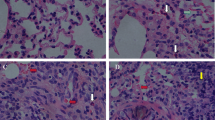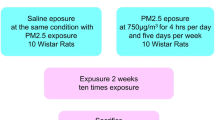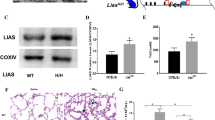Abstract
PM2.5 induces pulmonary inflammation via oxidative stress, and this role in the lungs is widely accepted, but studies on whether oxidative stress and inflammation can self-recover and be fully restored are limited. In this study, the oxidative stress and inflammation in the lungs of rats, which were first exposed to different PM2.5 dosages (0, 0.5, 3.0, and 15.0 mg/kg body weight) and different recovery days (0, 15, and 30 days) and then were exposed to the same PM2.5 dosages (30 mg/kg b.w.) after 30 days of recovery, were investigated. Results showed that the activity of superoxide dismutase (SOD) was significantly inhibited, and the levels of malondialdehyde (MDA), inducible nitric oxide synthase (iNOS), tumor necrosis factor-α (TNF-α), interleukin-6 (IL-6), and interleukin-1β (IL-1β) significantly increased. These changes were accompanied with damage to the pathological structure of the rat lungs. After stopping PM2.5 exposure, the difference between the PM2.5 group and the control group gradually decreased with the extension of recovery time. However, when the rats were again exposed to the same dose of PM2.5, the levels of IL-6, IL-1β, TNF-α, MDA, and iNOS were significantly increased, and the activities of SOD and GSH-Px were significantly inhibited in the high-dose group. And the high-dose group was accompanied by more severe lung pathological structural damage. Results showed that PM2.5 could induce oxidative stress and inflammatory damage in the lungs of rats, and these damages gradually recovered as exposure ceased, but increased lung susceptibility in rats.







Similar content being viewed by others
References
Alessandrini F, Beck-Speier I, Krappmann D, Weichenmeier I, Takenaka S, Karg E, Kloo B, Schulz H, Jakob T, Mempel M, Behrendt H (2009) Role of oxidative stress in ultrafine particle-induced exacerbation of allergic lung inflammation. Am J Respir Crit Care Med 179:984–991. https://doi.org/10.1164/rccm.200807-1061OC
Aztatzi-Aguilar OG, Uribe-Ramírez M, Arias-Montaño JA, Barbier O, Vizcaya-Ruiz AD (2015) Acute and subchronic exposure to air particulate matter induces expression of angiotensin and bradykinin-related genes in the lungs and heart: angiotensin-II type-I receptor as a molecular target of particulate matter exposure. Part Fibre Toxicol 12:17. https://doi.org/10.1186/s12989-015-0094-4
Aztatzi-Aguilar, O.G., Uribe-Ramírez, M., Narváez-Morales, J., Vizcaya-Ruiz A.D., 2016. Barbier O. early kidney damage induced by subchronic exposure to PM2.5 in rats. Part Fibre Toxicol. 13, 68. https://doi.org/10.1186/s12989-016-0179-8
Brucker N, Moro AM, Charão MF, Durgante J, Freitas F, Baierle M, Nascimento S, Gauer B, Bulcao RP, Bubols GB, Ferrari PD, Thiesen FV, Gioda A, Duarte MMMF, de Castro I, Saldiva PH, Garcia SC (2013) Biomarkers of occupational exposure to air pollution, inflammation and oxidative damage in taxi drivers. Sci Total Environ 463:884–893. https://doi.org/10.1016/j.scitotenv.2013.06.098
Buhalqem M, Meixner FX (2011) Air pollution and meteorological processes in the growing dryland city of Urumqi (Xinjiang, China). Sci Total Environ 409:1277–1290. https://doi.org/10.1016/j.scitotenv.2010.12.010
Chen PF, Bi XH, Zhang JQ, Wu JH, Feng YC (2015) Assessment of heavy metal pollution characteristics and human health risk of exposure to ambient PM2.5 in Tianjin, China. Particuology 20:104–109. https://doi.org/10.1016/j.partic.2014.04.020
Chen FE, Lin ZJ, Chen RJ, Dan N, Liu C, Kan HD, Deng QH, Huang C, Hu Y, Zou ZJ, Wei L, Wang J, Lu C, Qian H, Yang X, Zhang X, Qu F, Zhao ZH (2018) The effects of PM2.5 on asthmatic and allergic diseases or symptoms in preschool children of six Chinese cities, based on China, children, homes and health (CCHH) project. Environ Pollut 232:329–337. https://doi.org/10.1016/j.envpol.2017.08.072
Chen JD, Lu JJ, Ning JY, Yan YJ, Li SM, Zhou L (2019) Pollution characteristics, sources, and risk assessment of heavy metals and perfluorinated compounds in PM2.5 in major industrial city of northern Xinjiang, China. Air Qual Atmos Health 12:909–918. https://doi.org/10.1007/s11869-019-00706-8
Dagher Z, Garcon G, Gosset P, Ledoux F, Surpateanu G, Courcot D, Aboukais A, Puskaric E, Shirail P (2005) Pro-inflammatory effects of Dunkerque city air pollution particulate matter 2.5 in human epithelial lung cells (L132) in culture. J Appl Toxicol 25:166–175. https://doi.org/10.1002/jat.1050
Faridi S, Shamsipour M, Krzyzanowski M, Künzli N, Amini H, Azimi F, Malkawi M, Momeniha F, Gholampour A, Hassanvand MS, Naddafi K (2018) Long-term trends and health impact of PM2.5 and O3 in Tehran, Iran, 2006-2015. Environ Int 114:37–49. https://doi.org/10.1016/j.envint.2018.02.026
Feng JL, Chan CK, Fang M, Hu M, He LY, Tang XY (2006) Characteristics of organic matter in PM2.5 in Shanghai. Chemosphere 64:1393–1400. https://doi.org/10.1016/j.chemosphere.2005.12.026
Hamra GB, Guha N, Cohen A, Laden F, Raaschou-Nielsen O, Samet JM, Vineis P, Forastiere F, Saldiva P, Yorifuji T, Loomis D (2014) Outdoor particulate matter exposure and lung cancer: a systematic review and meta-analysis. Environ Health Perspect 122:906–911. https://doi.org/10.1289/ehp.1408092
Han LJ, Zhou WQ, Li WF, Li L (2014) Impact of urbanization level on urban air quality: a case of fine particles (PM2.5) in Chinese cities. Environ Pollut 194:163–170. https://doi.org/10.1016/j.envpol.2014.07.022
Han LJ, Zhou WQ, Li WF (2015) City as a major source area of fine particulate (PM2.5) in China. Environ Pollut 206:183–187. https://doi.org/10.1016/j.envpol.2015.06.038
Imane A, Ghidaa B, Anthony V, Frederic L, Mohamed R, Jean-Marc LG, Dominique C, Guillaume G (2019) In vitro evaluation of organic extractable matter from ambient PM2.5 using human bronchial epithelial BEAS-2B cells: cytotoxicity, oxidative stress, pro-inflammatory response, genotoxicity, and cell cycle deregulation. Environ Res 171:510–522. https://doi.org/10.1016/j.envres.2019.01.052
Jason B, Song H, Magdy S, Thomas K, Alghamdi MA, Khoder MI, Chen LC, Costa M (2014) Particulate matter from Saudi Arabia induces genes involved in inflammation, metabolic syndrome and atherosclerosis. J Toxicol Environ Health 77:751–766. https://doi.org/10.1080/15287394.2014.892446
Jedrychowski WA, Perera FP, Spengler JD, Mroz E, Stigter L, Flak E, Majewska R, Klimaszewska-Rembiasz M, Jacek R (2013) Intrauterine exposure to fine particulate matter as a risk factor for increased susceptibility to acute broncho-pulmonary infections in early childhood. Int J Hyg Environ Health 216:395–401. https://doi.org/10.1016/j.ijheh.2012.12.014
Jin, X.T., Su, H.L., Ding, G.B., Sun, Z..D., Li, Z.Y., 2019. Exposure to ambient fine particles causes abnormal energy metabolism and ATP decrease in lung tissues. Chemosphere, 224, 29–38. https://doi.org/10.1016/j.chemosphere.2019.02.116
Ku TT, Ji XT, Zhang YY, Li GK, Sang N (2016) PM2.5 , SO2 and NO2 co-exposure impairs neurobehavior and induces mitochondrial injuries in the mouse brain. Chemosphere 163:27–34. https://doi.org/10.1016/j.chemosphere.2016.08.009
Leclercq B, Alleman LY, Perdrix E, Riffault V, Happillon M, Strecker A, Lo-Guidice JM, Garcon G, Coddeville P (2017) Particulate metal bioaccessibility in physiological fluids and cell culture media: toxicological perspectives. Environ Res 156:148–157. https://doi.org/10.1016/j.envres.2017.03.029
Li N, Wang MY, Oberley TD, Sempf JM, Nel AE (2002a) Comparison of the pro-oxidative and proinflammatory effects of organic diesel exhaust particle chemicals in bronchial epithelial cells and macrophages. J Immunol 169:4531–4541. https://doi.org/10.4049/jimmunol.169.8.4531
Li N, Kim S, Wang M, Froines J, Sioutas C, Nel AE (2002b) Use of a stratified oxidative stress model to study the biological effects of ambient concentrated and diesel exhaust particulate matter. Inhal Toxicol 14:459–486. https://doi.org/10.1080/089583701753678571
Li N, Sioutas C, Cho A, Schmitz D, Misra C, Sempf J, Wang M, Oberley T, Froines J, Nel A (2003) Ultrafine particulate pollutants induce oxidative stress and mitochondrial damage. Environ Health Perspect 111:455–460. https://doi.org/10.1289/ehp.6000
Li N, Xia T, Nel AE (2008) The role of oxidative stress in ambient particulate matter-induced lung diseases and its implications in the toxicity of engineered nanoparticles. Free Radic Biol Med 44:1689–1699. https://doi.org/10.1016/j.freeradbiomed.2008.01.028
Li RJ, Kou XJ, Xie LZ, Cheng FQ, Geng H (2015a) Effects of ambient PM2.5 on pathological injury, inflammation, oxidative stress, metabolic enzyme activity, and expression of c-fos and c-Jun in lungs of rats. Environ Sci Pollut Res 22:20167–20176. https://doi.org/10.1007/s11356-015-5222-z
Li RJ, Kou XJ, Geng H, Xie JF, Tian JJ, Cai ZW, Dong C (2015b) Mitochondrial damage: an important mechanism of ambient PM2.5 exposure-induced acute heart injury in rats. J Hazard Mater 287:392–401. https://doi.org/10.1016/j.jhazmat.2015.02.006
Li JM, Han XL, Li X, Yang JP, Li XJ (2018) Spatiotemporal patterns of ground monitored PM2.5 concentrations in China in recent years. Int J Env Res Pub He 15:114. https://doi.org/10.3390/ijerph15010114
Liao DP, Shaffer ML, He F, Rodriguez-Colon S, Wu RL, Whitsel EA, Bixler EO, Cascio WE (2011) Fine particulate air pollution is associated with higher vulnerability to atrial fibrillation—the APACR study. J Toxicol Environ Health 74:693–705. https://doi.org/10.1080/15287394.2011.556056
Lim SS, Vos T, Flaxman AD, Danaei G, Shibuya K, Adair-Rohani H, AlMazroa MA, Amann M, Anderson HR, Andrews KG, Aryee M, Atkinson C, Bacchus LJ, Bahalim AN, Balakrishnan K, Balmes J, Barker-Collo S, Baxter A, Bell ML, Blore JD, Blyth F, Bonner C, Borges G, Bourne R, Boussinesq M, Brauer M, Brooks P, Bruce NG, Brunekreef B, Bryan-Hancock C, Bucello C, Buchbinder R, Bull F, Burnett RT, Byers TE, Calabria B, Carapetis J, Carnahan E, Chafe Z, Charlson F, Chen H, Chen JS, Cheng ATA, Child JC, Cohen A, Colson KE, Cowie BC, Darby S, Darling S, Davis A, Degenhardt L, Dentener F, Des Jarlais DC, Devries K, Dherani M, Ding EL, Dorsey ER, Driscoll T, Edmond K, Ali SE, Engell RE, Erwin PJ, Fahimi S, Falder G, Farzadfar F, Ferrari A, Finucane MM, Flaxman S, Fowkes FGR, Freedman G, Freeman MK, Gakidou E, Ghosh S, Giovannucci E, Gmel G, Graham K, Grainger R, Grant B, Gunnell D, Gutierrez HR, Hall W, Hoek HW, Hogan A, Hosgood HD III, Hoy D, Hu H, Hubbell BJ, Hutchings SJ, Ibeanusi SE, Jacklyn GL, Jasrasaria R, Jonas JB, Kan H, Kanis JA, Kassebaum N, Kawakami N, Khang YH, Khatibzadeh S, Khoo JP, Kok C, Laden F, Lalloo R, Lan Q, Lathlean T, Leasher JL, Leigh J, Li Y, Lin JK, Lipshultz SE, London S, Lozano R, Lu Y, Mak J, Malekzadeh R, Mallinger L, Marcenes W, March L, Marks R, Martin R, McGale P, McGrath J, Mehta S, Memish ZA, Mensah GA, Merriman TR, Micha R, Michaud C, Mishra V, Hanafiah KM, Mokdad AA, Morawska L, Mozaffarian D, Murphy T, Naghavi M, Neal B, Nelson PK, Nolla JM, Norman R, Olives C, Omer SB, Orchard J, Osborne R, Ostro B, Page A, Pandey KD, Parry CDH, Passmore E, Patra J, Pearce N, Pelizzari PM, Petzold M, Phillips MR, Pope D, Pope CA III, Powles J, Rao M, Razavi H, Rehfuess EA, Rehm JT, Ritz B, Rivara FP, Roberts T, Robinson C, Rodriguez-Portales JA, Romieu I, Room R, Rosenfeld LC, Roy A, Rushton L, Salomon JA, Sampson U, Sanchez-Riera L, Sanman E, Sapkota A, Seedat S, Shi P, Shield K, Shivakoti R, Singh GM, Sleet DA, Smith E, Smith KR, Stapelberg NJC, Steenland K, Stöckl H, Stovner LJ, Straif K, Straney L, Thurston GD, Tran JH, van Dingenen R, van Donkelaar A, Veerman JL, Vijayakumar L, Weintraub R, Weissman MM, White RA, Whiteford H, Wiersma ST, Wilkinson JD, Williams HC, Williams W, Wilson N, Woolf AD, Yip P, Zielinski JM, Lopez AD, Murray CJL, Ezzati M (2012) A comparative risk assessment of burden of disease and injury attributable to 67 risk factors and risk factor clusters in 21 regions, 1990–2010: a systematic analysis for the global burden of disease study 2010. Lancet 380:2224–2260. https://doi.org/10.1016/S0140-6736(12)61766-8
Liu J, Yang YY, Zeng XJ, Bo L, Jiang S, Du XH, Xie YQ, Jiang RF, Zhao JZ (2017) Investigation of selenium pretreatment in the attenuation of lung injury in rats induced by fine particulate matters. Environ Sci Pollut Res 24:4008–4017. https://doi.org/10.1007/s11356-016-8173-0
Mutlu GKM, David G, Amy B, Baker CM, Burgess Z, Rajamannan N, Christman JW, Foiles N, Kamp DW, Ghio AJ, Chandel NS, Dean DA, Sznajder JI, Budinger GRS (2007) Ambient particulate matter accelerates coagulation via an IL-6-dependent pathway. J Clin Investig 117:2952–2961. https://doi.org/10.1172/JCI30639
Nel AE, Diaz-Sanchez D, Li N (2001) The role of particulate pollutants in pulmonary inflammation and asthma: evidence for the involvement of organic chemicals and oxidative stress. Curr Opin Pulm Med 7:20–26. https://doi.org/10.1097/00063198-200101000-00004
Riva DR, Magalheas CB, Lopes AA, Lancas T, Mauad T, Malm O, Valenca SS, Saldiva PH, Faffe DS, Zin WA (2011) Low dose of fine particulate matter (PM2.5) can induce acute oxidative stress, inflammation and pulmonary impairment in healthy mice. Inhal Toxicol 23:257–267. https://doi.org/10.3109/08958378.2011.566290
Saldiva PH, Clarke RW, Coull BA, Stearns RC, Lawrence J, Murthy GG, Diaz E, Koutrakis P, Suh H, Tsuda A, Godleski JJ (2002) Lung inflammation induced by concentrated ambient air particles is related to particle composition. Am J Respir Crit Care Med 165:1610–1617. https://doi.org/10.1164/rccm.2106102
Shi YF, Zhao T, Yang XZ, Sun BY, Li Y, Duan JC, Sun ZW (2019) PM2.5-induced alteration of DNA methylation and RNA-transcription are associated with inflammatory response and lung injury. Sci Total Environ 650:908–921. https://doi.org/10.1016/j.scitotenv.2018.09.085
Sies H (1991) Oxidative stress: from basic research to clinical application. Am J Med 91:31S–38S. https://doi.org/10.1016/0002-9343(91)90281-2
Sun XW, Chen PL, Ren L, Lin YN, Zhou JP, Ni L, Li QY (2018) The cumulative effect of air pollutants on the acute exacerbation of COPD in Shanghai, China. Sci Total Environ 622-623:875–881. https://doi.org/10.1016/j.scitotenv.2017.12.042
Tao F, Gonzalezflecha B, Kobzik L (2003) Reactive oxygen species in pulmonary inflammation by ambient particulates. Free Radic Biol Med 35:327–340. https://doi.org/10.1016/S0891-5849(03)00280-6
Turap Y., Rekefu S., Wang G., Talifu D., Gao B., Aierken T., Hao S., Wang X., Tursun Y., Maihemuti M., 2019. Chemical characteristics and source apportionment of PM2.5 during winter in the southern part of Urumqi, China. Aerosol Air Qual Res, 19(6). https://doi.org/10.4209/aaqr.2018.12.0454
Wagner JG, Kamal AS, Morishita M, Dvonch JT, Harkema JR, Rohr AC (2014) PM2.5-induced cardiovascular dysregulation in rats is associated with elemental carbon and temperature-resolved carbon subfractions. Particle and fibre toxicology, 11, 25. https://doi.org/10.1186/1743-8977-11-25
Wang GH, Jiang RF, Zhao ZH, Song WM (2013) Effects of ozone and fine particulate matter (PM2.5) on rat system inflammation and cardiac function. Toxicol Lett 217(1):23–33. https://doi.org/10.1016/j.toxlet.2012.11.009
Wang GH, Zhao JZ, Jiang RF, Song WM (2015) Rat lung response to ozone and fine particulate matter (PM2.5) exposures. Environ Toxicol 30:343–356. https://doi.org/10.1002/tox.21912
Wang R, Xiao X, Cao L, Shen ZX, Lei Y, Cao YX (2016) Airborne fine particulate matter induces an upregulation of endothelin receptors on rat bronchi. Environ Pollut 209:11–20. https://doi.org/10.1016/j.envpol.2015.10.043
Weldy CS, Liu YG, Chang YC, Medvedev IO, Fox JR, Larson TV, Chien WM, Chin MT (2013) In utero and early life exposure to diesel exhaust air pollution increases adult susceptibility to heart failure in mice. Part Fibre Toxicol 10:59. https://doi.org/10.1186/1743-8977-10-59
Ye XF, Peng L, Kan HD, Wang WB, Geng FH, Mu Z, Zhou J, Yang DD (2016) Acute effects of particulate air pollution on the incidence of coronary heart disease in Shanghai, China. PLoS One 11:e0151119. https://doi.org/10.1371/journal.pone.0151119
Ye WF, Ma ZY, Ha XZ (2018) Spatial-temporal patterns of PM2.5 concentrations for 338 Chinese cities. Sci Total Environ 631–632:524–533. https://doi.org/10.1016/j.scitotenv.2018.03.057
Yue WS, Li XL, Liu JF, Li Y, Yu XH, Deng B, Wan TM, Zhang GL, Huang YY, He W, Hua W, Shao LY, Li WJ, Yang SS (2006) Characterization of PM2.5 in the ambient air of Shanghai city by analyzing individual particles. Sci Total Environ 368:916–925. https://doi.org/10.1016/j.scitotenv.2006.03.043
Zhang K, Guo L, Wei QZ, Song QQ, Liu JT, Niu JP, Zhang L, Ruan Y, Luo B (2018a) COPD rat model is more susceptible to cold stress and PM2.5 exposure and the underlying mechanism. Environ Pollut 241:26–34. https://doi.org/10.1016/j.envpol.2018.05.034
Zhang Q, Li QZ, Ma JC, Zhao YP (2018b) PM2.5 impairs neurobehavior by oxidative stress and myelin sheaths injury of brain in the rat. Environ Pollut 242:994–1001. https://doi.org/10.1016/j.envpol.2018.07.031
Zhang J, Liu J, Ren L, Wei J, Duan J, Zhang L, Zhou X, Sun Z (2018c) PM2.5 induces male reproductive toxicity via mitochondrial dysfunction, DNA damage and RIPK1 mediated apoptotic signaling pathway. Sci Total Environ 634:1435–1444. https://doi.org/10.1016/j.scitotenv.2018.03.383
Zhang M, Li HD, Li HC, Zhao XC, Zhou Q, Rao QC, Han YQ, Lan YN, Deng H, Sun XP, Lou X, Ye CH, Zhou X (2019) Quantitative evaluation of lung injury caused by PM2.5 using hyperpolarized gas magnetic resonance. Magnetic resonance in medicine. https://doi.org/10.1002/mrm.28145
Zhao H, Li WX, Gao YF, Li JQ, Wang HB (2014) Exposure to particular matter increases susceptibility to respiratory Staphylococcus aureus infection in rats via reducing pulmonary natural killer cells. Toxicology 325:180–188. https://doi.org/10.1016/j.tox.2014.09.006
Acknowledgments
This work was financed by the National Natural Science Foundation of China (No. 21667026) and the Social Science Foundation of Xinjiang Production and Construction Corps (No. 18YB13).
Author information
Authors and Affiliations
Contributions
HR and JL designed the study, analyzed the experimental results, and wrote the manuscript. HR, JN, XS, and YT conducted the animal experiments, HR, YD, and JC contributed to the analysis of the data. All authors read and approved the final manuscript.
Corresponding authors
Ethics declarations
Current study involves animal subjects, and the study has been reviewed and approved by the Ethics Committee which is affiliated with the First Affiliated Hospital, School of Medicine, Shihezi University, Shihezi 832002, China (Approval No.: A2017-005-01).
Conflict of interest
The authors declare that they have no conflict of interest.
Additional information
Responsible Editor: Philipp Gariguess
Publisher’s note
Springer Nature remains neutral with regard to jurisdictional claims in published maps and institutional affiliations.
Rights and permissions
About this article
Cite this article
Ren, H., Lu, J., Ning, J. et al. Exposure to fine particulate matter induces self-recovery and susceptibility of oxidative stress and inflammation in rat lungs. Environ Sci Pollut Res 27, 40262–40276 (2020). https://doi.org/10.1007/s11356-020-10029-2
Received:
Accepted:
Published:
Issue Date:
DOI: https://doi.org/10.1007/s11356-020-10029-2




